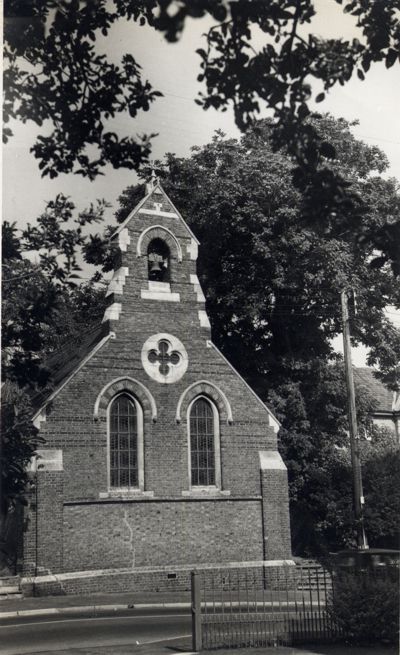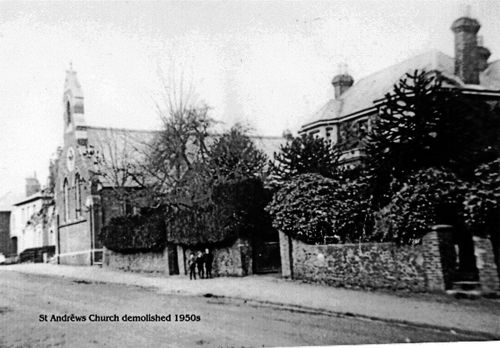St Andrew's Church, Greenstreet Hill
Our request in the Spring 2012 Edition of Teynham News has prompted a great deal of interest. One of the difficulties the Editorial Committee had was to find a good photograph of the Church, they seem to be rather rare. Imagine the Committee Members' pleasure when Mr Bernard Cork supplied the picture on the front cover to accompany his article. He had spoken to Mr John Thomas who lives in London Road of his intention of writing a piece on it and lo  and behold Mr Thomas produced the photograph. It was the very first picture Mr Thomas took with his very first camera. Thank you very much Mr Thomas for the loan of the picture.
and behold Mr Thomas produced the photograph. It was the very first picture Mr Thomas took with his very first camera. Thank you very much Mr Thomas for the loan of the picture.
Mr Eric Lewis wrote that, as a child, he was told that St Andrews church was built by the donation of a local farmer left in his will. There was only one vicar for both Teynham churches, so he only preached in St Andrews one Sunday a month. As a school boy he was in the choir and also sang there once a month. As far as he understood, it was finally demolished because it was sitting on a seam of blue clay and was begining to split, (the same seam that caused so much havoc on the A2, on the way to Canterbury, when the bank kept sliding into the nearside lane). One of the things Eric remembered as a child was that a lot of the pews were reserved by people who had bought them.
Matthew Austen emailed on behalf of his grandmother who was keen to share what she knew of the church:
My grandmother is Mrs Betty Austen (nee Parks) who was born in Teynham High Street in 1921 and was christened in St Andrews Church, she remembers it well. It was a Church of England church and her mother went to church there every Sunday. She cannot recall the date of her christening.
My Nan isn't so sure it was demolished in the 1950's and believes this to be wrong and too late, on the basis that a neighbour of hers (Mr Bray) was a builder at that time, working for Wildish, and commented at the time that the demolition of the church (the reason for which had been cited locally as crumbling foundations) was not for the reasons given, as the foundations were solid. It was believed (although we cannot substantiate) the Church of England wanted it out the way and had sold the land it stood on. My Nan remembers her Mum saying the congregation did start to dwindle at one point as Greenstreet grew, people moved further afield. (maybe the real reason the church was closed and demolished). Mr Bray died while my Nan was young, she would have been in her 30's in 1950's and was not living at home then, hence why she questions the date given.
One thing my Nan is sure about is all through her life it was always a church and never operated as anything else. The above may be of more use when viewed in light of others information, much like putting together a big jigsaw."
Mr Barry Knell emailed "You have probably been informed by now anyway, but St Andrews church was demolished because it had serious subsidence problems. We lived at number 17 London Road, three doors away from it during the war and I remember playing around there and even though I was very young at the time I remember it had huge cracks running through the walls. I don't know who owned the land?"
Mrs Brightman phoned to say that her brother, sister and her were all members of the Choir at St. Andrews Church when the Vicar was the Rev. Purser. She believes the Curate's name was Mr Newell and the Choir Master, Mr Carter whose wife played the organ. Mr Ernie Madgwick and Mr Doug Stubbings were also in the choir. Their Sundays were - Sunday morning service at St. Andrews to sing in the choir; Sunday afternoon - Sunday School at St. Marys and Sunday evenings back to St. Andrews to sing in the choir for the Evening Service.
Mrs Brightman lived with her parents and siblings in a cottage in London Road (with a couple living at the top - Mr & Mrs Oven) near the Dover Castle (where Mr & Mrs Cheeseman have since had their house built) and the cottage was pulled down because of the foundations. They shared a well for water and shared the toilet in the garden with Mr & Mrs Oven.
Mr David Stanley, of Nutberry Close, bought us a copy of S. Mary with S. Andrew Parish Magazine dated June 1941, price 11/2d, in which his baptism at St Andrew's Church was recorded. Whilst confirmations are also recorded in the magazine these, as Mr Cork writes, possibly all took place at St Mary's.
The Clergy are recorded in the magazine as Rev. W.C.B. Purser and Rev. T.G. Williams (The Gables, London Road), who was also the General Scout Master and Cub Master. The Churchwardens for St Andrew's were Messrs A.H. Carter and A.E. Parris. Mrs Carter was the Organist with Messrs H. King and W. Lewis as Honorary Organists for both churches. It is worthy of note that Walter Lewis is still the Organist at St Mary's after 70 years.
St Andrew's Church even had its own choir, as remembered by Mrs Brightman, comprising of Choirmen Messrs A.H. Carter, A.F. Parris, T.C. French, H.H. Home and C. Harvey.
Rev. Williams records that the amount collected for the ‘Waifs and Strays' in their Lent Savings' boxes was £3 13s 9d. They also needed more Sunday School teachers, asking parishioners to help. The Cubs also paraded at St. Andrew's on 27th April, the Sunday nearest to St George's Day. The Address was given by Rev. Ehrinann and the collection, amounting to 12s 7d, was given to the Greek Relief Fund (to help in the Greek war effort).
The magazine records Children's Services and a Sunday School under Miss M. Datson, being held in Conyer and a S. Mary's Hall, with Hon. Sec. Mr W.R. Jones, 10 Eastwood Cottages. Do any readers have memories of these. Where was the hall located? Do you have a photograph of the hall when it was in Conyer?
All of the above leads nicely onto the story of St Andrew's as a building as researched by Mr Bernard Cork.
St Andrew's Church, Greenstreet Hill
Up until the 1950's whenever you approached Greenstreet along the A2 from Sittingbourne or Faversham this imposing building, with its tall slender Bell Tower housing its one and only bell, broke the skyline catching the traveller's eye, as may be seen in the photograph.
 To make this possible the internal layout was altered to accommodate rows of pews for the use of worshippers and the fitting of a font for baptisms. A Harmonium, provided by the congregation, was also installed and a choir formed under the leadership of the then Incumbent. To complete the conversion the walls were painted white with a large deep blue dado running round. A small building was annexed to the West wall to serve as a Vestry. It is of interest to note that subsequent to this conversion that £29 10s 0d. was raised annually from pews rented by the local gentry.
To make this possible the internal layout was altered to accommodate rows of pews for the use of worshippers and the fitting of a font for baptisms. A Harmonium, provided by the congregation, was also installed and a choir formed under the leadership of the then Incumbent. To complete the conversion the walls were painted white with a large deep blue dado running round. A small building was annexed to the West wall to serve as a Vestry. It is of interest to note that subsequent to this conversion that £29 10s 0d. was raised annually from pews rented by the local gentry.
The following years showed the Church being well attended with services being held each Sunday evening at 6.30pm with Holy Communion being taken on the 3rd and 5th Sundays in the month at 8.00am. On each Saints Day these were held at the earlier time of 7.30am. In addition Midnight Mass was conducted at Christmas time. Parishioners were summoned to each service by the monotonous tolling of the bell for a period of 20 minutes prior to the service time; however this practice was discontinued during the war period. In the Second World War, St. Andrew's windows were 'blacked out' to comply with war time regulations, which then made it possible for evening meetings to continue. This certainly helped the situation when St. Mary's suffered structural blast damage when a landmine exploded close to the Church. At this time the greater number of people lived in the Greenstreet area so it was natural that the active life of the Parish should continue unaffectedly at St. Andrew's.
Research of previous records provide no evidence of Weddings, Burials or Confirmations having taken place at St. Andrews but Baptisms were certainly conducted as normal. Sunday School classes took place and were well attended. In addition the Church was used for the Girl Guides, Scouts and Cubs Organisations when parades and services were held.
Whilst St. Andrews was still active there were three commemorative brass plates contained on the walls, one being in memory of Mr James Lake, benefactor of the original building, one for the local GP Dr. Pritchard who resided at ‘Brusons House' and which was presented by 250 of his patients, the third plate being in honour of James Frederick Honeyball of New Gardens. It is a great shame that the final resting place of these brass plates and the one solitary bell remain unknown since the Church was demolished in 1951.
It is widely thought that the demolition was occasioned by the presence of cracks appearing in the brickwork through 'land slipping', and the necessity for 'underpinning' repair work and its associated costs. However when the demolition was carried out by the local builder, Mr P Wildash of Greenstreet, the work took longer than scheduled, the building appearing to be less unstable than at first thought.
The site has remained vacant for the last 60 years.
Mr Bernard Cork